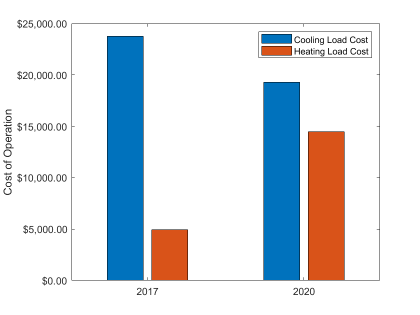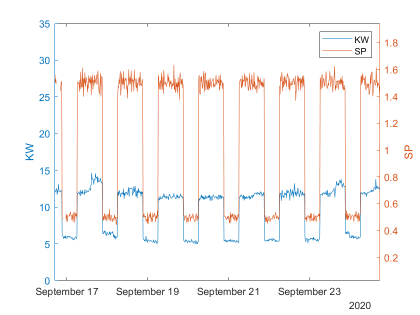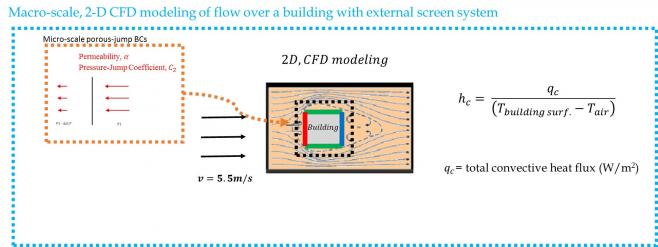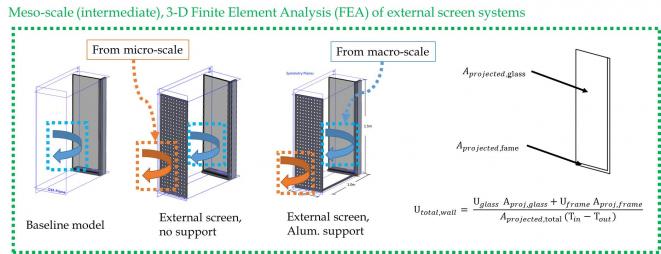Building Sustainability into Control Systems > Student Projects
*Past Student Projects:
A Methodology for Reducing Building Energy Usage (Spring 2014)
Building Fault Diagnosis: Air-Handling Unit and Cogeneration Case Studies (Spring 2016)
Technical and Economic Assessment of Cogeneration Systems in an Urban Academic Building (Spring 2014 & 2017)
Degree of Comfort: A Thermal Comfort Study of 41 Cooper Square (Spring 2014)
@41CooperSquare: Energy Dashboard for an Educational Building in NYC (Spring 2014)
Creating an Energy Model of 41 Cooper Square (Spring 2013)
Investigating thermal performance of double-skin perforated-sheet façade using multi-scale approach (Spring 2016)
Chiller Plant Optimization (Condenser Water Reset) (Fall 2020)
Laboratory Ventilation Energy Conservation Measures (Fall 2016)
Analysis of Air System Operations and Nighttime Static Pressure Reset to Reduce Energy Consumption (Spring 2021)
*A Methodology for Reducing Building Energy Usage (Spring 2014)
Eric Leong, ME ’14 and Gregori Tayco, ME ‘14
Presented at 2014 ASEE Zone 1 Conference Student Poster Competition and 2014 NYC Dept. of Design and Construction’s (NYCDDC) Town+Gown and Industry City poster exhibits
Buildings sector comprises a large portion of energy consumption. Internationally, it represents 32% of global consumption 41% of U.S. energy consumption. Therefore it is critical to focus on the reduction of energy usage in existing buildings for reducing global energy consumption. This project focuses on The Cooper Union’s LEED Platinum certified academic building, 41 Cooper Square.
By observing its energy consumption, areas with the greatest potential for energy savings can be monitored to improve operational use and reduce energy usage. This project examines different methods to characterize energy use and proposes strategies to reduce consumption. Though this process was applied to 41 Cooper Square, the procedure is designed to be applicable to other building systems.
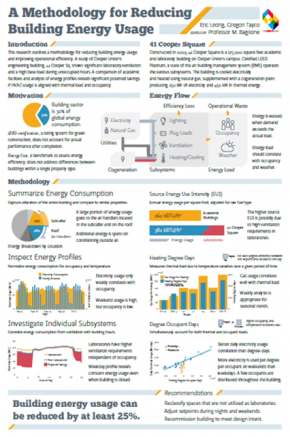
Click here for a PDF of the project poster
Click here for ASEE Zone 1 conference abstract
Click here for Senior Capstone Design report
Use of Sankey Diagrams to Model Building Energy Flow and Visualize Savings from Optimizing Air Delivery Systems (Fall 2020)
William Lim, ME ‘18
Buildings are comprised of a multitude of systems which help the building function and keep its occupants comfortable. Tracking the building’s energy flow helps building owners and operators gauge how and where buildings consume energy. Building Management Systems (BMS) and BACnet connectivity along with external asset and data management systems enable detailed visualization of a building’s energy flows, which facilitates equipment and controls optimization to reduce energy consumption. This project uses Sankey diagrams— that allow for the visualization of varying energy flow quantities—to thoroughly portray energy distribution in an academic building before and after execution of air delivery energy conservation measures. The flow visualization demonstrates energy streams composed of a source and a terminal representing ways energy is distributed throughout the building.
41 Cooper Square Energy Analytics Tool (Fall 2016)
Zhengqi Xi (ME'17)
An Energy Analytics tool, which can only be accessed from the Cooper network, was created that queries and analyzes data from Powerdash. The analytics engine splits the data into nighttime usage and daytime usage to get a better understanding of building usage at night. This can give clues to the equipment that is being utilized heavily at nighttime, despite the decrease in occupancy. The dashboard will allow users to query a time period, and calculate average, total, maximum and minimum total building usage for the time period. Users can also dig deeper into individual distribution boards and calculate the same metrics for specific boards, along with several others. Metadata, such as the equipment tied to distribution board, can also be easily viewed.
*Building Fault Diagnosis: Air-Handling Unit and Cogeneration Case Studies (Spring 2016)
Alex Bush, ME ’16 and Joe Viola, ME ‘16
The goal of this project is to develop tools for building retuning which can facilitate the monitoring and verification of building data, increase energy efficiency, and reduce operational cost. The building retuning and fault diagnosis process was applied to air handlers and cogeneration plants at Cooper Union. This project developed tools in Matlab and Excel to analyze data from the Building Management System and cogen plants and investigate opportunties for energy and cost savings.

Click here for a PDF of the project poster.
Click here for AHU Case Study technical report.
*Technical and Economic Assessment of Cogeneration Systems in an Urban Academic Building (Spring 2014)
Cogeneration is the use of a heat engine to simultaneously generate electricity and heat. Power plants produce electricity but reject heat to the atmosphere and have grid losses. By using on-site cogeneration instead of buying electricity from the utility, efficiency is increased from 40 to 80 percent.
Jonathan Rodriguez, MME ‘14
Presented at 2014 NYC Dept. of Design and Construction’s (NYCDDC) Town+Gown and Industry City poster exhibits and 2014 GE Global Research Summit
A technical and economic assessment of the 250 kW cogeneration system at 41 Cooper Square was performed using a mathematical simulation. The cogeneration system was commissioned in December 2011 with a capital investment of $1.2 million of which $400,000 was funded through a grant from the New York State Energy Research Development Authority (NYSERDA). The system as currently configured reduces annual utility expenses by about $101,000 per year compared to the direct purchase of electricity and natural gas from the utility grid. These savings account for the annual maintenance associated with cogeneration and represents a payback time of 8 years (equivalently a 13% return on Cooper Union’s investment). The analysis revealed four key deficiencies that hinder its full performance potential, all of which could be eliminated by physical retrofits.
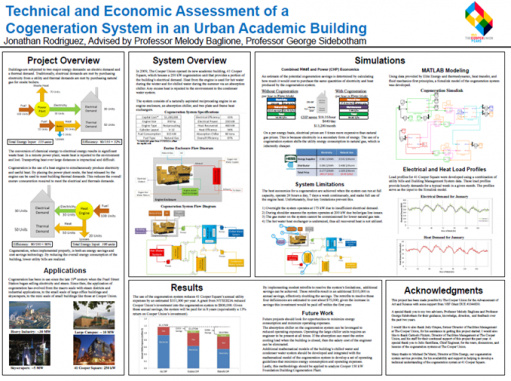
Click here for a PDF of the project poster
Soyoung Moon, ME ‘17
The 250 kW and 150 kW cogeneration plants at the 41 Cooper Square and the Foundation Building save Cooper Union around $130,000 annually. By analyzing sensor data and developing analysis tools, students have identified that increasing heat recovery and uptime has the potential to save an additional $200,000 annually.
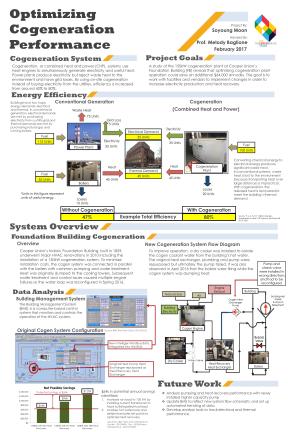
Click here for a PDF of the project poster
*Degree of Comfort: A Thermal Comfort Study of 41 Cooper Square (Spring 2014)
Yudi Guo, ME ’14 and Daniel Moreno, ME ‘14
Presented at 2014 NYC Dept. of Design and Construction’s (NYCDDC) Town+Gown and Industry City poster exhibits
The thermal comfort of an indoor environment is essential to maintaining occupant productivity and health. Comfort in 41 Cooper Square is primarily controlled by the radiant panels, which affect the air temperature in the room, and the air handling units (AHUs), which influence humidity and air speed. However, it is also highly subjective and can vary from person to person. This study assessed the overall comfort of the building using both Building Management System (BMS) data and results from surveys that were administered to building occupants, comparing them to a standardized scale used for evaluating comfort in building design. In the study it was found that overall, the building is generally perceived to be slightly cold, suggesting that comfort could be improved by raising room temperature set points, especially during summer months, or by reducing drafts by lowering ventilation rates whenever possible.
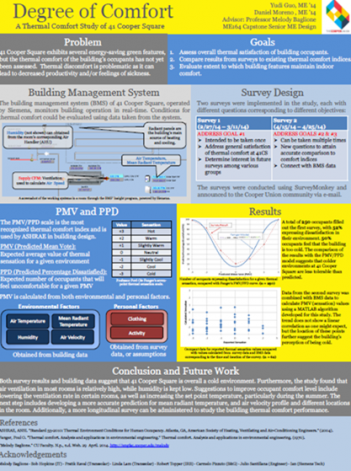
Click here for a PDF of the project poster
*@41CooperSquare: Energy Dashboard for an Educational Building in NYC (Spring 2014)
Janet Butler, ME ’14 and Polina Smirnova, ME ‘14
Presented at 2014 NYC Dept. of Design and Construction’s (NYCDDC) Town+Gown and Industry City poster exhibits
Highly efficient buildings often decrease in optimal energy performance after five years of occupancy. To prevent loss in energy efficiency, it is necessary to engage occupants in understanding the purpose of green features implemented in building operation. An energy dashboard was built to inform building occupants and engineering students on the effectiveness of wide array of green features located at 41 Cooper Square. A public website, at41coopersquare.github.io, was created and is hosted on a kiosk in the lobby of The Cooper Union’s academic building at 41 Cooper Square.

Click here for a PDF of the project poster
*Creating an Energy Model of 41 Cooper Square (Spring 2013)
Sara Carlson, ME ‘13
An energy model of 41 Cooper Square (41 CS) is made in the building simulation program eQUEST. The data used to populate the model is gathered from several sources including construction drawings of the building, the code and report of the energy model made by IBE Consulting Engineers, and the Siemens Building Management System (BMS). The resulting energy model is used to predict the building’s energy usage. The cost of annual combined gas and electric utilities is used as the basis to compare the accuracy of the energy model to 41 CS. The model predicts an annual energy cost of $1,036,000, which is within 10% of the actual utility costs for 2011, $934,000. The model is used to perform a sensitivity analysis on zone thermostat setpoints and predicts that increasing the cooling setpoint from 72°F to 76°F and reducing the heating setpoint from 72°F to 68°F will save approximately $38,000 in annual utility costs.
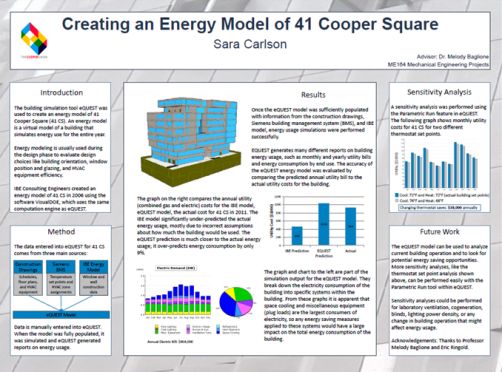
Click here for a PDF of the project poster
*Investigating thermal performance of double-skin perforated-sheet façade using multi-scale approach
Woojae Kim, MME '16
This thesis research investigates the insulating performance of screen systems, specifically, the combined effects of thermally bridging elements and wind sheltering, provided by external screens. In order to quantify these effects, U-factors of simple glazed wall assemblies with and without external screens were calculated and compared. To calculate the U-factors, this research proposes a multi-step modeling approach to minimize the computational costs of explicit modeling of screen systems. At various length scales, Computational Fluid Dynamics (CFD) modeling as well as thermal Finite Element Analysis (FEA) were used to analyze various components of screen systems and their thermal performances. From the analyses, it was concluded that the insulating benefits gained from the wind sheltering were marginal under the boundary conditions specified by the National Fenestration Rating Council (NFRC). The overall U-factors of façades with screen systems degraded due to the increased surface exposure and thermal bridging when compared to a baseline façade without any screen.
This research also investigates the solar shading performance of screen systems. In order to quantify the impacts of varying screen properties on overall building energy consumption, a commercial office space in New York, NY was simulated in COMFEN, an energy modeling software, and analyzed. For orientations where high solar irradiation is expected, solar shading from external screens resulted in overall energy savings by reducing the cooling loads. For orientations with marginal solar exposure, however, screen systems resulted in higher annual energy consumption due to increased lighting demand caused by blockage of visible light. Based on the analyses performed in this research, it was concluded that a screen system should be considered for a project after analyzing it for a specific site and quantifying the benefits it may provide throughout the life-cycle of the building.
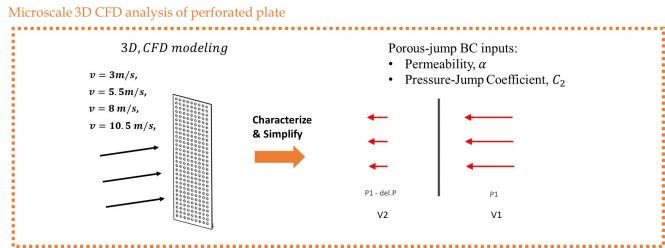
*The Application of Numerical Methods and Artificial Intelligence to the Building Management System in a LEED Certified Academic Building (41 Cooper Square)
Michael Sterman, MME '12
Presented at ASME 2012 International Mechanical Engineering Congress
In this Master's thesis, neural networks are applied to predict the energy consumption of a LEED-certified academic building (41 Cooper Square). A neural network model was validated to be accurate within an average absolute error of 33.4 kW, or approximately 5.0% of the total electricity consumption of the building, for weekdays when school was in session. Innovations in this neural network model include the use of solar position as a variable, which was incorporated to address 41CS’s specific situation. Neural networks and Least Mean Squares (LMS) were also used to simulate the temperature of a classroom given various parameters, including CO2 concentrations. The use of CO2 concentrations is shown to significantly increase the accuracy of the predictions. A new predictive control system that uses CO2 concentration to anticipate thermal demand and control the radiant panels in a classroom was simulated. Results suggest incorporating CO2 concentrations as inputs in temperature control has the potential to improve HVAC system performance. Click here for the conference proceedings.
*Development of a Calibrated Whole-Building Heat Balance Energy Model for a High-Performance Academic Building
Eric Ringold, MME '16
High performance buildings comprise numerous interacting systems that contribute to energy consumption. Simulating this complex interaction requires sophisticated analysis software and equally sophisticated understanding of how the models represent the physical systems in the building. This research evaluates the important energy-related building systems of 41 Cooper Square using the open, extensible, and rigorous building simulation engine, EnergyPlus. This research translated the complex systems in 41 Cooper Square into a comprehensive model and compared the model’s performance to the building’s actual energy consumption. The research investigated two approaches to calibrating the energy model: one using hourly metered power consumption data and another using monthly utility consumption. The approaches explored different time variation profiles of internal energy consumption as the primary calibration variable, and showed that model agreement with measured data depends on similarity of time scales between inputs and comparison data. A fully realized whole-building energy model tuned to match measured energy consumption can improve understanding of building physics and contribute to future research on efficient building operation.
Chiller Plant Optimization for Increased Building Efficiency (Fall 2020)
Andrew Chin, MME '20
Condenser water supply temperature (CWST) resets are control strategies that reduce chiller plant energy consumption. Optimizing the CWST based on parameters such as outside wet bulb temperature, chiller load, and chilled water supply temperature (CHWST) setpoints can minimize total power across chiller plant components. An algorithm was developed for finding the optimal CWST for a given chiller plant. The algorithm generates lookup tables that show the optimal CWST and minimal power for a set of operating conditions. The results of the algorithm suggest three beneficial sequences of operation: resetting the CWST setpoint based on weather and cooling demand, running multiple cooling towers, and distributing chiller loads evenly. Click here for ASHRAE publication.
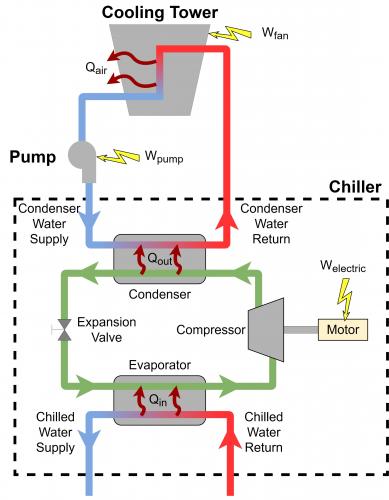


*Laboratory Ventilation Energy Conservation Measures
Tony Zhao, ME '17
Laboratory ventilation systems in academic research buildings are significant source of energy consumption. Laboratories require extra ventilation compared to classrooms and offices to maintain a safe environment. This project analyzes the laboratory ventilation system of 41 Cooper Square and investigates opportunities for reducing energy use and costs. A study of the overall laboratory ventilation system is done to identify laboratories that are being over ventilated as well as exhaust fans that are not operating properly. Savings can come from reducing the amount of airflow while satisfying building codes and optimizing exhaust fan operation.
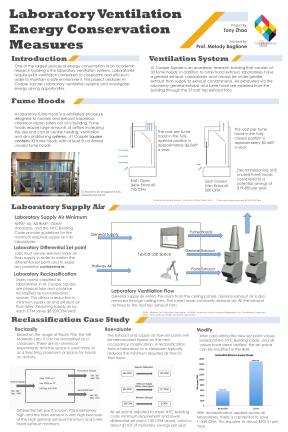
Click here for a PDF of the project poster
Chong Woo (John) Han, MME '16
Laboratories consume a significant amount of energy due to extra ventilation requirements and special laboratory equipment, such as fume hoods. An automated tool was developed to assess fume hood usage patterns and identify unused and mismanaged fume hoods. Computational fluid dynamics was applied to study the effects of reducing laboratory air change rates and fume hood face velocities on safety. Additional energy savings could come from decommissioning unused fume hoods as well as optimizing laboratory exhaust fan operation.
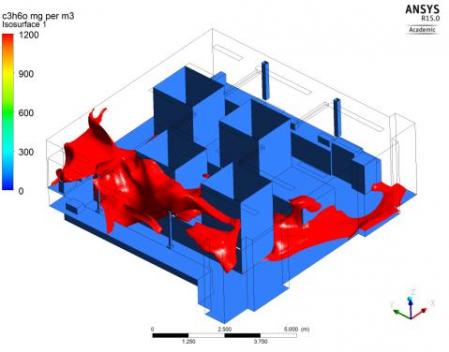
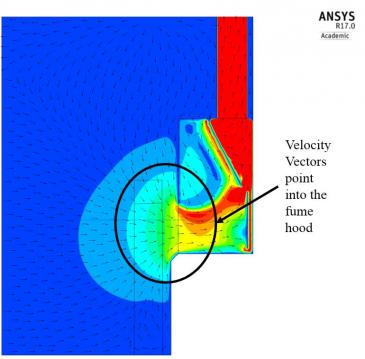
Analysis of Air System Operations and Nighttime Static Pressure Reset to Reduce Energy Consumption (Spring 2021)
Andrew Mosin, ME '19

